If you’ve ever been frustrated by a chatbot on a company’s website, you’ll understand how important it is for businesses to offer good customer support through a functional chatbot that helps users to find answers to their questions, rather than creating even more questions.
To ensure you don’t offer your customers the same poor experience you’ve encountered in the past, the key is starting with the right chatbot tool, careful customer journey design and then continuous improvement.
Done well, chatbots can not only enhance your customer experience, they can also play a key role in both acquiring and retaining customers. Let’s take a deep dive into chatbots to see how they could work for your business.
What are chatbots?
Most of us have had at least a couple of encounters with a chatbot, but just in case you’re not sure what we’re talking about…
A chatbot is a computer program that simulates human conversation. The bot appears on a website, either popping up on every page across the site, or on specific pages, where website users can start a conversation. They might be looking for information on a business’ opening hours, want to find out how to return an order, or need to make a complaint.
The bot can then either signpost them to the right place to find the information they need, or pass them onto a team member to handle the conversation.
You can customise your bot to suit the needs of both your business and customers so it saves your team time and effort, and helps your customers to find the right solution faster.
The rise of the bot
Chatbots are becoming increasingly popular. HubSpot’s Not Another State of Marketing Report 2021 found that the use of chatbots has more than doubled since 2020, with a third of all marketers now using them.
But it’s not just marketers that should sit up and take notice of chatbots, as customers are increasingly expecting to see them across the board on websites they visit. A study by Conversocial found that 48% of customers are comfortable using bots, and 71% said that they’d be happy to use a bot if it meant they had a better experience.
What’s more, HubSpot found that 40% of customers don’t mind whether they talk to a human support advisor or a chatbot, as long as they get the support they need. But that support needs to come quickly. When it comes to response times, 90% of customers state that an “immediate” response is either important or very important when they have a customer service question. And by “immediate”, they mean 10 minutes or less – at least according to 60% of customers.
A chatbot offers the best opportunity for you to meet those tight deadlines. Rather than forcing your customers to listen to hold music whilst waiting to speak to a customer support agent on the phone, a chatbot could work out what they want, direct them towards the information they need, and retain a happy customer.
It’ll make you happier as a business owner, too. IBM found that chatbots can save businesses up to 30% on their customer support costs, thanks to automation. With a chatbot, you can quickly qualify leads, book meetings and create support tickets, freeing up time so you can focus on other things.
What is conversation marketing?
Looking for another reason to add a bot to your website? Conversational marketing. It’s a new way of marketing that speaks directly to customers, using artificial intelligence (including chatbots) to make traditional marketing more interactive. Think about it: traditionally, sales people have “the gift of the gab”. So why shouldn’t your website be able to interact with people in the same way?
For conversational marketing to be effective, the conversations need to happen on the customer’s time. That means being available for them whenever suits them, whether that’s at 7am or 11pm.
Using a chatbot on your site allows customers to ask questions, allowing you to find out what they’re looking for in their own words. Over time, you’ll gather more information both about individual users and trends across your customer base. If you see, for example, that five people a day are having trouble trying to apply a discount code they’ve been sent, then you’ll know that’s a pain point and you need to review your messaging to ensure that all users know what to do without having to get in touch.
Compared to website forms, chatbots allow you to collect customer information in a more natural way. This feeling of comfort and familiarity with your brand could get you more business, as evidenced by HubSpot itself. When it added live chat to its site, the brand attracted 20% more qualified leads.
But, of course, it needs to be personalised for it to work well. If you were reaching out to a friend for support, you wouldn’t expect to have to tell them your name, and repeat the details of your problem every time you spoke. The same is true for customers when they reach out to your business. If you don’t personalise your interactions with users, you run the risk of annoying them and losing them as a customer or not gaining them as a new customer.
Personalisation and contextualisation based on what you already know about your customers (thanks to information they provide and data already recorded in your CRM) are key to offering a good chatbot experience.
How you can use HubSpot bots on your website
We feel every site should have a chatbot now and that they should be playing a key role in your sales and customer retention strategies. If you use HubSpot, it’s easy to add a bot to your site – and here are just some of its capabilities:
- Serve different chatbots to different people
- Serve different chatbots on different pages across your site, or only target specific pages with a bot
- Add users to a subscriber list after they offer their information
- Become more personalised over time to further improve their effectiveness
- Allow seamless pass off to human agents as required
You can also use the chatbot in combination with a self-serve knowledge base or a FAQ section, offering customers the ability to find information in the way that suits them best.
Hannah, Attacat’s Inbound Marketing Manager, shows how you can easily create a chat in HubSpot.

If you would like to see other videos of our favourite HubSpot features, just click on the link.
Giving bright enthusiastic graduates their first break has been a long time passion of Tim’s.
“ I feel that there are two schools of thought about hiring people with no previous experience. The first is to make sure that anyone without experience gets nowhere near client projects. The alternative view is that they will learn much more quickly if they are involved at the outset. In fact we’ve found that they often bring new ideas to the table. Our experience of employing graduates has been a very positive one and is supported by our clients too.”
Last year, in the depths of the second lockdown* and at a time when graduate prospects didn’t look all that great, we were able to create two more graduate jobs. One year on we now have two rising stars: Ryan and Marlena.
We thought you’d like to learn a bit more about them and see what they’ve been up to since they joined from Edinburgh University Business School.
Marlena Vollmer
“I joined Attacat as a graduate and was immediately impressed with the support and trust I was given from Day 1. Despite Covid-19, I feel that I have had the chance to get to know and connect with my colleagues. But what really sets Attacat apart is how everyone is treated as an individual.
I feel heard – my opinions and ideas are welcomed, my needs are met, and my career path is guided by my strengths and interests. Progression is not a rigid path and instead adapted to a person’s career goals, making it the perfect place to grow and be challenged.
I am so appreciative of the time I am spending at Attacat, as I have been able to learn more about myself and experience what a healthy and exciting work environment looks like.”
Ryan Lees
“Looking back on my time with Attacat so far, it’s clear to see just how much I have come on within PPC. From day one I was welcomed into and made feel a part of the team. It sounds a cliché, but it really is a friendly and helpful culture within the workplace.
Everyone is willing to help others when needed and the social aspect to the office is a real bonus. What sets Attacat apart for me is that you can choose your own path here, you may start in PPC but you can change and transition to working with the Organic team or the tech side of things.
There really are no limits for what you can do with Attacat, within reason – although, the coffee machine in the kitchen could be the start of your barista passion! Regardless of whether you want to transition into a new area within the company or really hone your skills in a specific area, Attacat is there to support you with the Learning & Development on offer. Ultimately, working with Attacat is what you make of it but you can be certain that when working here you will grow your skills exponentially.”

If you haven’t already had the chance to meet Marlena or Ryan, we’ll introduce you the next time you’re in our office. We’re sure you will be just as impressed as we have been. And if you are currently studying but looking for your next work opportunity, get in touch.
As businesses, we need to evaluate our digital marketing plans on a regular basis. We need to ask ourselves how effective we are and could we be more efficient. In other words, are we spending time and money doing the right things and, when we are, could we achieve even more with the time and resources we have?
Here are three different angles to look at your existing digital marketing plan from.
1. What are your metrics saying about current performance?
Across all your digital marketing activity, what is working for you and what is not? Use the data to give you the objective view.
Data is the key to measuring effectiveness because you can not only see how you are performing against any KPIs you have set, you can often also measure against industry standards too.
For assessing channels, we’ve always been big fans of metrics that get as close to the money as practical. In ecommerce we focus on revenue generated (and better still profit, cost of customer acquisition and customer lifetime value). When leads are the lifeblood of the business it’s about doing what you can to tie leads to those same metrics.
Good old fashioned funnel metrics are also interesting. What are your conversion rates telling you and where are you seeing the drop-offs in the process?
It’s also important to consider more forward looking indicators that give an indication of the momentum you are building up. In most cases here, it’s the trend you are interested in. Falling numbers spell future trouble, rising numbers indicate glory is around the corner.
Here’s some specific momentum metrics to think about:
- Click-through rate (CTR) is great because it works across landing pages, emails and ads and will measure the percent of people who click on a link
- Social media engagement such as likes and replies (preferable to the number of followers!)
- Active subscribers
- Active customers, and possibly the most important of all, Net Promoter Score
Make measurement part of your regular marketing activity and look for incremental gain rather big shifts. Be ruthless and honest too.
2. Are we making best use of all our resources?
In marketing terms, your resources are person hours, budget and existing assets. It is really important to make effective and efficient use of them all.
Person hours
For your people’s time, “Eliminate, automate or outsource” is a useful process to go through. Get your team to look at all the work they are doing and put it through these three tests:
- Test 1 – Eliminate
Ask “Can I eliminate this work?” i.e. does doing this bit of work actually deliver a result? We’ve all come across plenty of situations where work is done because “we’ve always done this”!
If the work is delivering value then go to the next test. - Test 2 – Automate
“Can I automate this bit of work?”. If so do it! But failing that go to test 3 - Test 3 – Outsource
Would outsourcing this work deliver a better return than it being done in house. Don’t forget to consider the opportunity cost of your team not being able to deliver what only they are able to deliver in this analysis.
Budgets
For budgets, data measurement as previously mentioned is clearly one way of calculating what is working for your business and what is not and potentially deploying a budget to other actions.
Assets
This is the category of resource that is most often overlooked. You will have several assets that can be leveraged, often with very little cost and frequently delivering returns. Some examples include:
- Your existing web presence – every article, video, pdf to name but a few has the potential to be repurposed and reused. Even small pieces of content can be packaged up as so called “snippets”. An example is the link to an appointment calendar at the bottom of this article. It is set-up as a snippet and can be added to all relevant content.
- Training materials – could they be repacked into an online resource for your customers? Likewise customer service playbooks and knowledge bases – can you get them online and opened up to search engines?
- Event content – you did video that amazing event you did last month didn’t you?!
- Software and digital services – do you have anything behind closed doors that could be, with a little work, polished up and made available online to more of your potential customers?
- Your products – do you have products that have a high perceived value but a low cost to you?
- The other teams in your business. Sometimes some small shifts in mindset or changed habits from other people in your business can begin to add a lot to your digital presence. For example your customer service agents and sales people will be explaining things to customers everyday. Going a little bit further and using those customer questions as triggers, to write something down for a webpage or record a quick video, can start to create large volumes of useful content that can be used as part of your SEO for example.
- Your customers – do you have large numbers of raving fans that you aren’t asking for reviews? Or could help out your other customers?
- Your buildings – do you have under-utilised space? It’s no coincidence that BMW offers BMW owners free coffee whenever they want it and banks create co-working spaces. We offer our spare desks to our clients to use whenever they are in Edinburgh. It all contributes to the marketing in one way or another
- Your partners – everyone from your suppliers to your CSR partners are people that have the potential to help you. They may be able to offer competition prizes or exposure to their audience for example?
3. Have we got the right system infrastructure?
Does your company have the system infrastructure to deliver effectiveness and efficiency? For many businesses that have evolved their digital marketing over time, they have acquired a number of different applications for the different tasks. That might include a dedicated email platform, a social media aggregator, an ecommerce platform and a live chat app for example.
All work well independently but are they holding back your growth by slowing your team down?
Many businesses are hampered by the difficulty of collating data and information across different systems and an inability to see a complete picture of how the marketing activity is performing in the context of the entire customer lifecycle journey.
Do your systems allow you to meet the expectations of seamless customer service? Is your marketing team seen as an ally of your sales and customer service teams and vice versa? Can you deploy content and offer service quickly across websites, email, chat and social platforms? Can you automate activities based on what your customers do on your website or any other channel? Can you personalise all these channels?
If the answer to any of these questions is no, then that’s an indication that your marketing plan is likely to be held back by your systems. Of course it may not be practical or sensible to have all these capabilities straight away but it does make sense to work out what you do need and what you are likely to need and build from there.
If you have been speaking to us at all in the last few years or beyond then you will of course know that we believe the key is having a CRM (Customer Relationship Management) based system at the heart of your digital presence.
Summary
The truth is that carrying out the above evaluation will probably raise more questions than it answers, but that is a good thing. Answering the difficult questions about both your effectiveness and efficiency will undoubtedly point your digital marketing activity in the right direction. It might just need a tweak to your original plan or it might need a total reset.
Whatever the requirement is, it will be time well spent. If there is something you would like to know more about, please just ask.
HubSpot integrations are one of the platform’s secret weapons. If you’re currently using lots of different tools and having to jump between platforms, or need to manually compile data from different sources, then HubSpot integrations are the solution to your problems.
Integrations on HubSpot connect different platforms, giving you easier access to multiple data points and helping your different departments to work together better as a team. But what are the best integrations? Let’s take a look.
What does HubSpot integrate with?
HubSpot integrates with hundreds of different third-party applications, making it easier for these platforms to share information with HubSpot – and vice versa. Integrating HubSpot with other types of software is useful for businesses of every size and in every vertical. Whether you’re focused on selling products and services, need to connect with your customers, or want to optimise workflows across your company, there are HubSpot integrations to benefit you.
Best HubSpot integrations
Of course, the best integrations for you will depend on your needs, and whether you need software to power up your sales team, simplify your marketing efforts, make analytics easier, improve workflow, or support with content creation. But to get you started, here are some of our favourites, chosen from over 900 integrations available in the HubSpot App Ecosystem.
PandaDoc
PandaDoc and HubSpots native integration allows you to generate and edit sales collateral, contracts and other documents directly from HubSpot. It allows your Sales & Account Management team to pull Deal, Contact & Company information such as address, name & deal amount directly into your proposals.
Combined with eSignatures, this integration can enable Sales rep to automate reminders to necessary team members as soon as the eSignature has been completed, streamlining the handover process between Sales & Delivery.
With detailed analytics and tracking, on the number of views, opens & clicks you can have full visibility over the performance of each document.
This is a great integration for Marketers that send out a lot of guides & brochures as well as Sales reps with their proposals and quotes.
HubSpot calendar integration
You can sync HubSpot to either your Google Calendar or Outlook Calendar, meaning that
you can create a meeting in your CRM, create a calendar event for the meeting and send invites, all from HubSpot.
Similarly, if you create an event in either your Google or Outlook Calendar with someone who’s a contact in HubSpot, it’ll appear in their contact record timeline. With the HubSpot meetings tool, your prospects can simply pop onto your calendar and book out a meeting slot that works for both of you, saving you both from back-and-forth emails about potential meeting times.
If you use Calendly for appointment scheduling, you can also integrate it with HubSpot, allowing you to embed Calendly onto your HubSpot website and in emails. Any time a meeting is created, rescheduled or cancelled, it’ll automatically update the information in HubSpot.
This is great for Sales Managers, who are now able to attribute the impact of different types of meetings to each and every closed or lost deal in HubSpot.
LinkedIn Sales Navigator
LinkedIn is a powerful tool for sales reps, and the LinkedIn Sales Navigator helps you to keep up to date with all of your contacts, allowing you to message people outside of your contacts, conduct advanced searches, and create custom account lists.
If you use HubSpot Sales Hub, you can integrate LinkedIn Sales Navigator to get all of the tool’s features within the CRM, making it easier to make new connections and follow up with your existing ones, without having to switch between platforms. You’ll also Get LinkedIn Sales Navigator information like recommended leads and connections on your HubSpot company records, helping you to better understand your key accounts.
Xero
If you use Xero for your accounting, why not integrate it with HubSpot? Doing so will ensure you have a full overview of your cash flow from within your CRM. It makes life easier when your sales team can create invoices directly from HubSpot, knowing that they’ll be automatically synced to Xero for approval from your accounts team.
With the integration, your Xero contacts will be available in HubSpot making it easier to keep on top of inbound sales and ensuring any changes automatically get pulled through to your CRM so you don’t lose valuable information or waste time making manual updates. Having an overview of where your customers and prospects sit helps your sales and customer service teams to determine whether there’s an up- or cross-sell opportunity.
If you are an Account Manager or Customer Service Rep who needs to be able to see at a glance if your customers are up to date on all their payments, or when their next payment is due then this is a really useful integration. Removing the need for you to jump between systems.
Salesforce
Salesforce, like HubSpot, is a CRM – so you might be wondering, why would you need to integrate two rival platforms? Well, if your marketing team uses HubSpot but your sales team uses Salesforce, it’ll make life easier for both departments if you sync them up to ensure that data is shared and any changes are automatically synced between platforms.
Syncing up these two platforms could be what you need to close the loop between your sales and marketing teams, ensuring they stay aligned and working towards the same common goals. You can use the data from your Salesforce contacts to personalise marketing emails or to segment your database, and you’ll be able to tie specific marketing campaigns to revenue with better insights into your leads and wins.
OrgChartHub
If you struggle to keep on top of who’s who for your different prospects and client accounts, then you need OrgChartHub. You can build organisational charts for each of your accounts within the HubSpot CRM, and every member of your team can easily add and edit the charts without having to switch logins or platforms.
Integrating the two means you can easily add any HubSpot contact properties to your cards to give your team extra insights, and you’ll be able to monitor sales and marketing activity across stakeholders and accounts using activity heatmaps. This makes it easy to spot anywhere you might be over- or under-servicing clients or prospects.
Slack
If you use Slack to communicate with colleagues, then integrating it with HubSpot will make your life much easier. As well as getting HubSpot notifications directly in Slack, you can also create a task and associate it with a contact, company or deal in HubSpot from Slack without having to switch platforms.
Integrating the two platforms will make it easier for you to link up the dialogue happening internally with what your sales pipeline looks like. You’ll also be able to save time when you’re on the move by using slash commands to search for and share a HubSpot CRM contact – perfect when one of your reps is en route to a meeting and needs as much information about the attendees as possible!
Shopify
Shopify & HubSpot are able to integrate seamlessly, enabling you to bring inbound into your marketing mix. Allowing you to analyse your shopify data in HubSpot, the integration brings with it a suite of reports, including average order value, lifetime order value & abandoned cart recovery rate.
Use shopify data to segment audiences for email marketing & ad audiences to deliver a personalised experience to all of your customers. Use the combination of Shopify & HubSpot data to report on the impact of your sales team in driving e-commerce sales via Shopify & vice versa.
WhatsApp Integration
With more and more businesses using WhatsApp as a communication channel, it’s important that you can now integrate those conversations with HubSpot. The WhatsApp integration allows you to communicate directly with your customers and record all support conversations on the HubSpot Contact timeline.
It will even integrate with HubSpot Workflows so that you can automate your WhatsApp communications. You will also be able to receive notifications for new messages from WhatsApp which can add leads to the HubSpot CRM.
HubSpot PayPal integration
Although HubSpot announced new native payment processing at their INBOUND 21 conference, this is currently only available in the USA. Until it’s rolled out to the rest of the world, consider integrating HubSpot with DepositFix, which allows for payment via Stripe and PayPal.
DepositFix allows you to customise the payment process, all of which can be controlled via your CRM. Some of the things you’ll be able to do include:
- Accept payment on your HubSpot landing pages, keeping clients on your website
- Segment contacts in HubSpot using payment fields
- Add custom fields to payment fields
- Send receipts using HubSpot email workflows
- Manage billing information within the CRM
Insycle Data Management
It’s important to keep on top of your contacts in HubSpot, otherwise, you’ll end up with incorrect data. Whether that’s due to user error or the passage of time, it’ll have an impact on your bottom line, with Gartner finding that the average financial impact of poor data quality on organisations was $15 million per year. Cleaning up your data will save time and improve employee efficiency, as well as improving customer satisfaction and making for more efficient, targeted marketing campaigns.
Insycle Data Management does the hard work for you by fixing data errors at the source. When you integrate it with HubSpot, you’ll be able to automatically fix incorrect data entries in HubSpot Workflows, merge duplicate contacts, and ensure entries are formatted properly. You’ll also be able to automate data clean up using schedules and workflow integration.
Interested in finding out more about integrations, or need a hand in getting them set up? Get in touch with us today for a chat about our HubSpot integration services.
Adobe Campaign v HubSpot Marketing Hub
A recent survey by G2* carried out a comparison between the above two products which we think is of interest to people who are thinking about using marketing automation and analytics tools as part of their customer relationship management strategy.
Price shouldn’t always be the criteria, but one of the things that HubSpot does very well is allow SMEs to start using their marketing hub for free and pricing it as the business grows and needs more features. You can also have a free trial of any of their pricing models
Marketing Hub Free £0. Marketing Hub Starter £38 Per Month.
Marketing Hub Professional £655 Per Month. Marketing Hub Enterprise £2,624 Per Month.
HubSpot also makes this information available on their website whereas you need to get a quote from Adobe, and they don’t offer a free trial. So, it is difficult to compare the two products on price.
One other significant point to note is that the HubSpot platform is based on it being a CRM. In other words, if a business does not already have a customer database, it’s included in the HubSpot package. If a business does have a CRM, then HubSpot will likely be able to integrate with it too.
Adobe Campaign does not have a CRM built in. Not an issue if the business already subscribes to Adobe Marketing Cloud – although that is only available as an enterprise solution. It is likely that it will be able to integrate with other CRMs although that will be an additional cost. If HubSpot was required to integrate with another CRM rather than using the inbuilt one, then there would be an additional cost for that integration as well.
Features Comparison
G2 looked at the following features and compared both products.
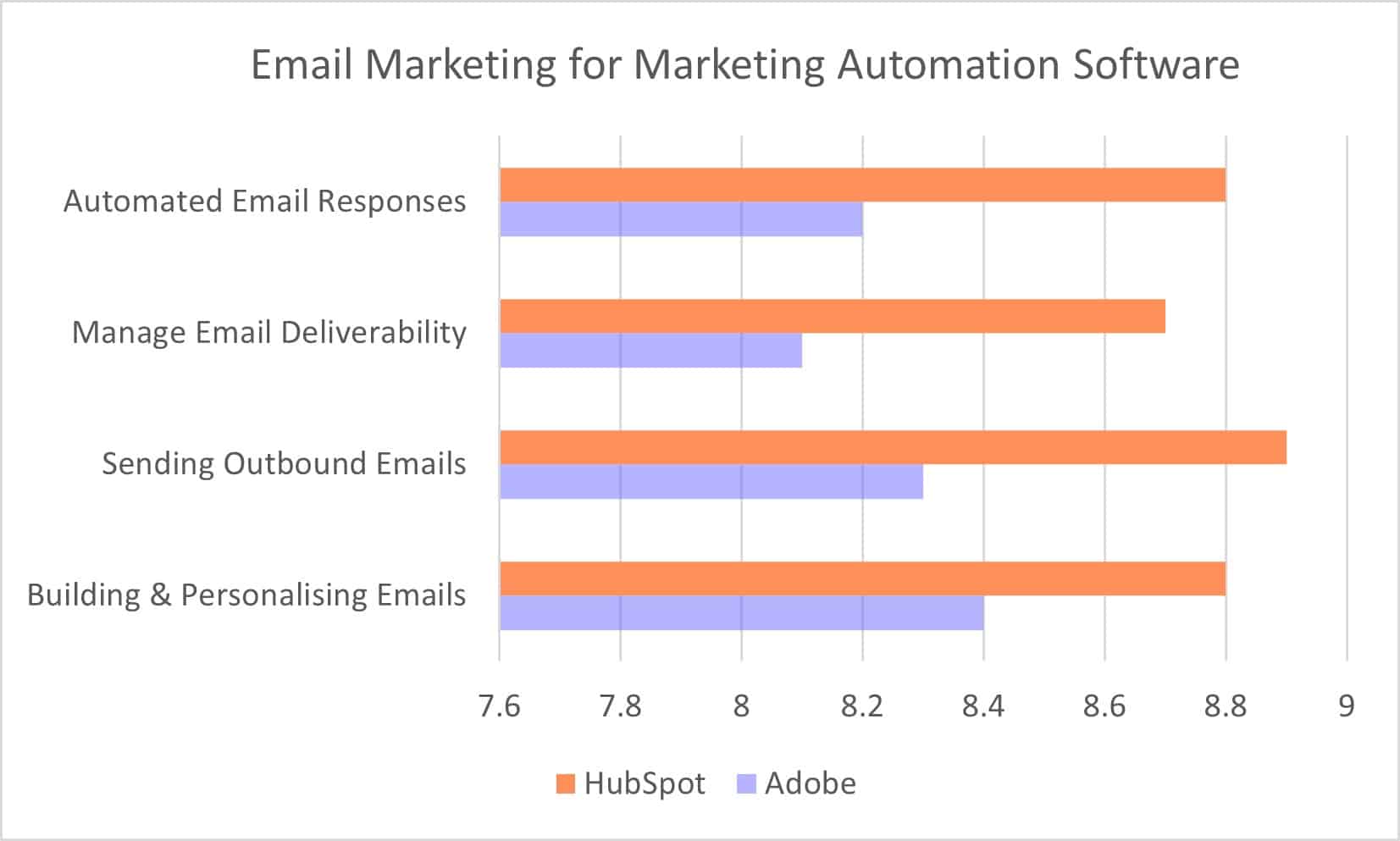
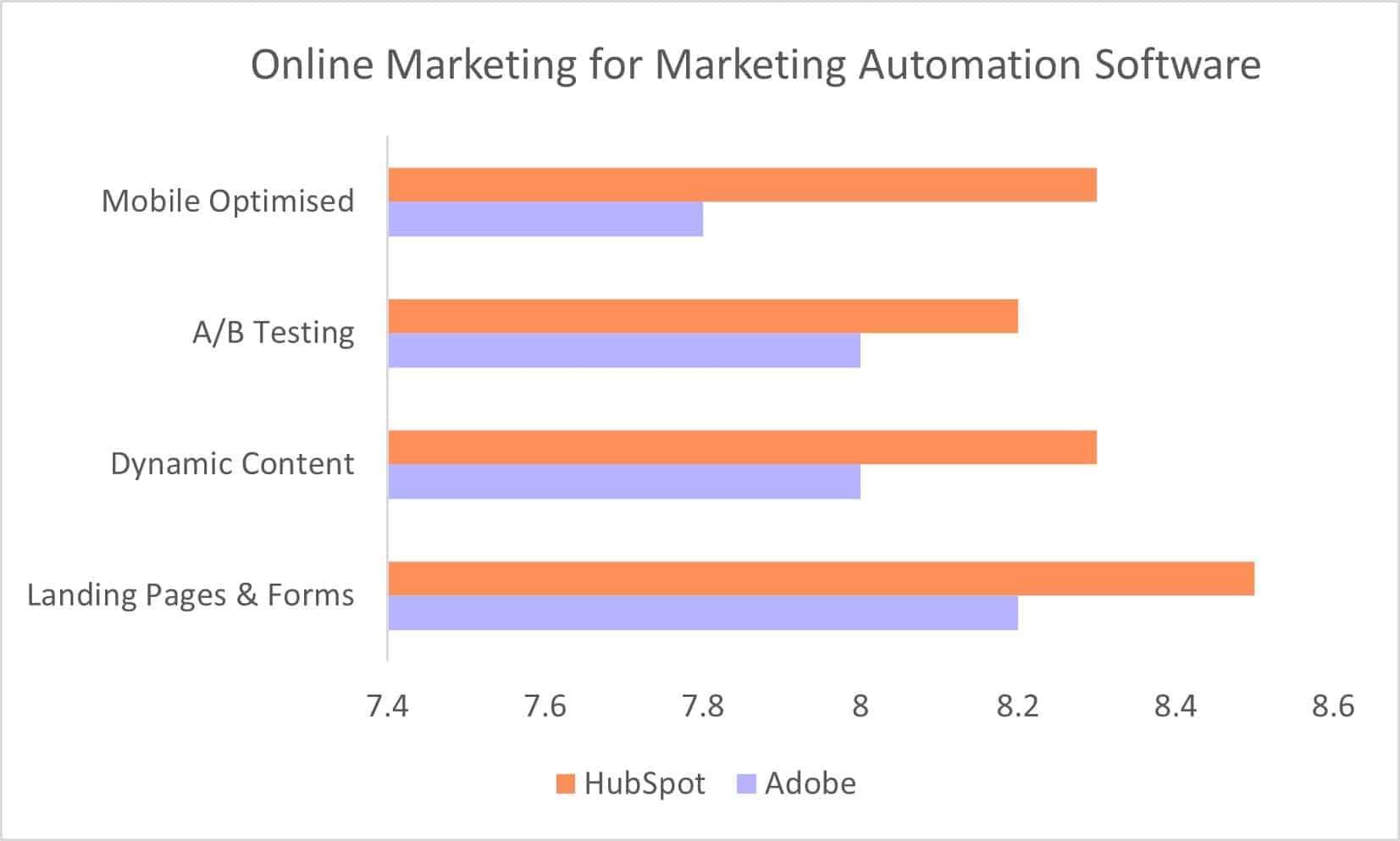
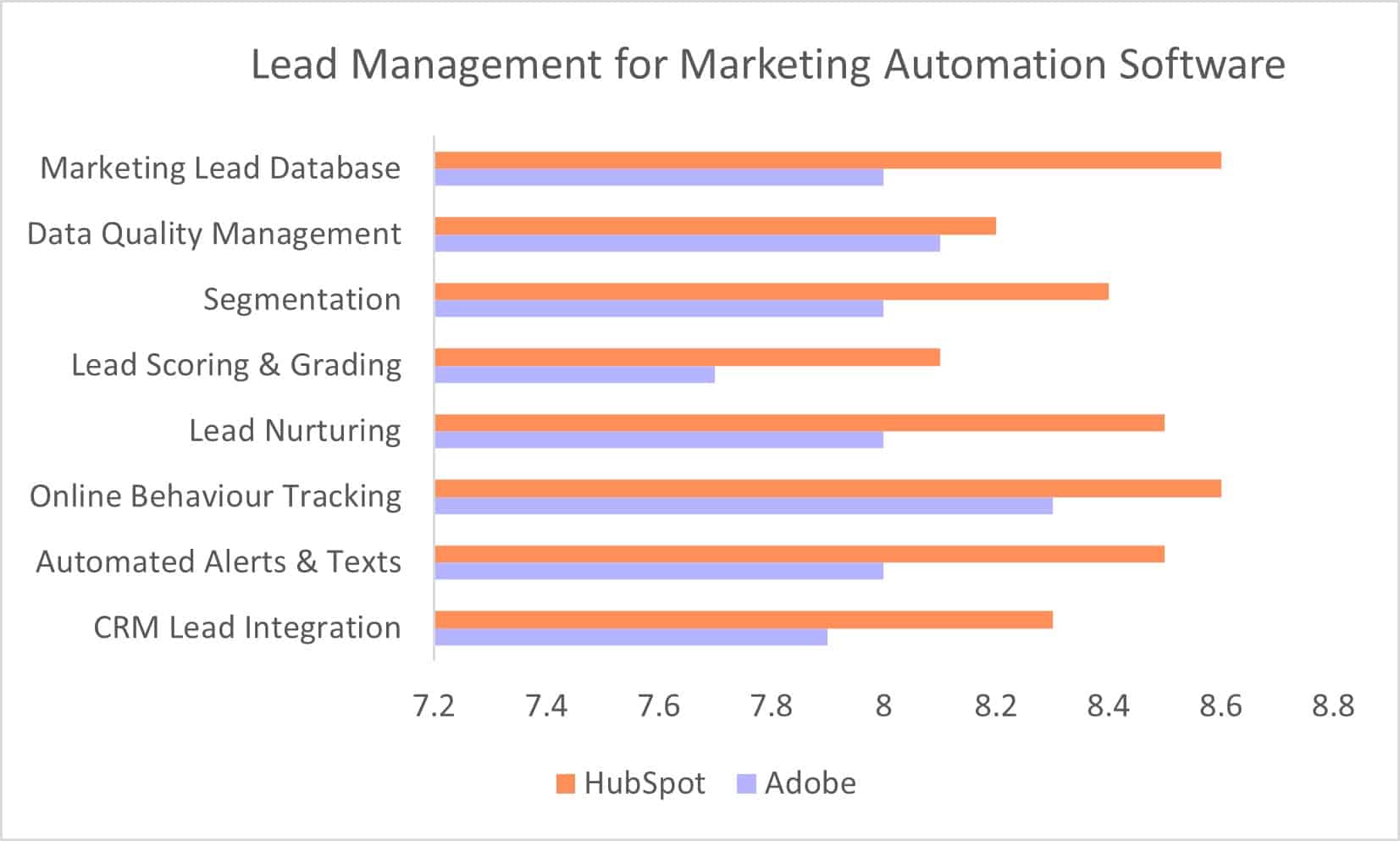
So, when it comes to using the platform as a marketing tool, it is clear that HubSpot scores better in every criterion compared to Adobe Campaign. Using the tool however is only part of the process and when it came to measuring the results, Adobe Campaign started to score better.
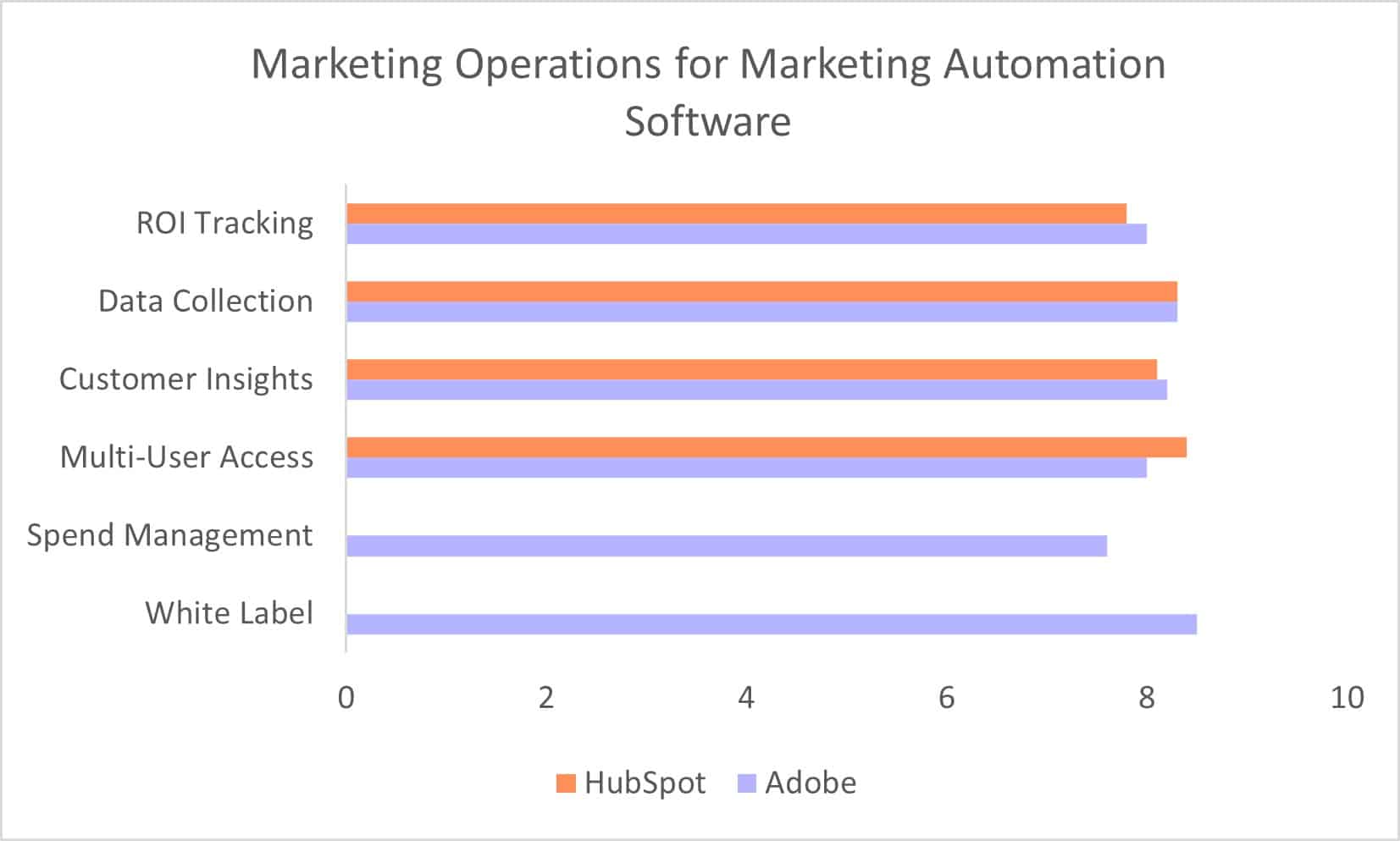
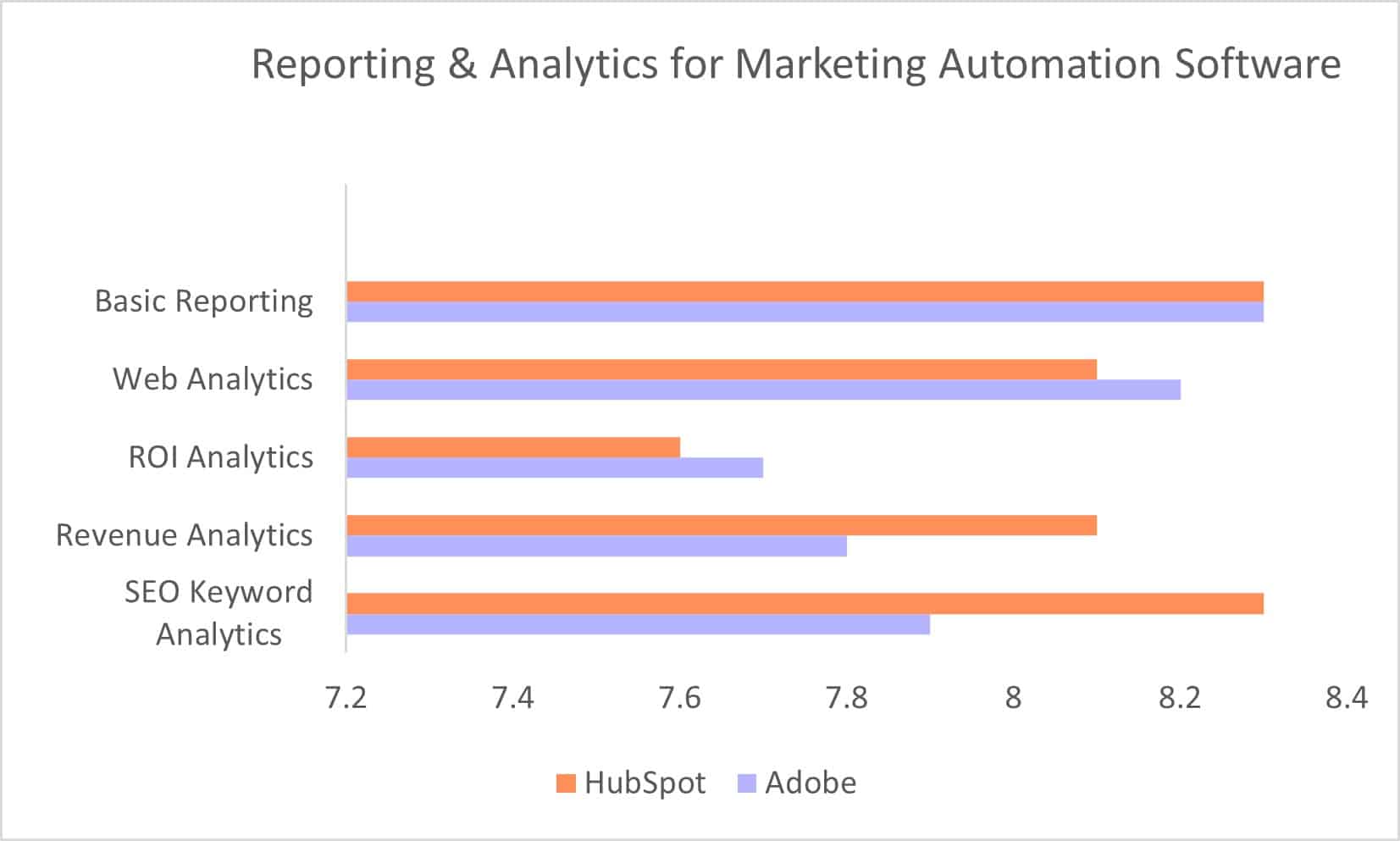
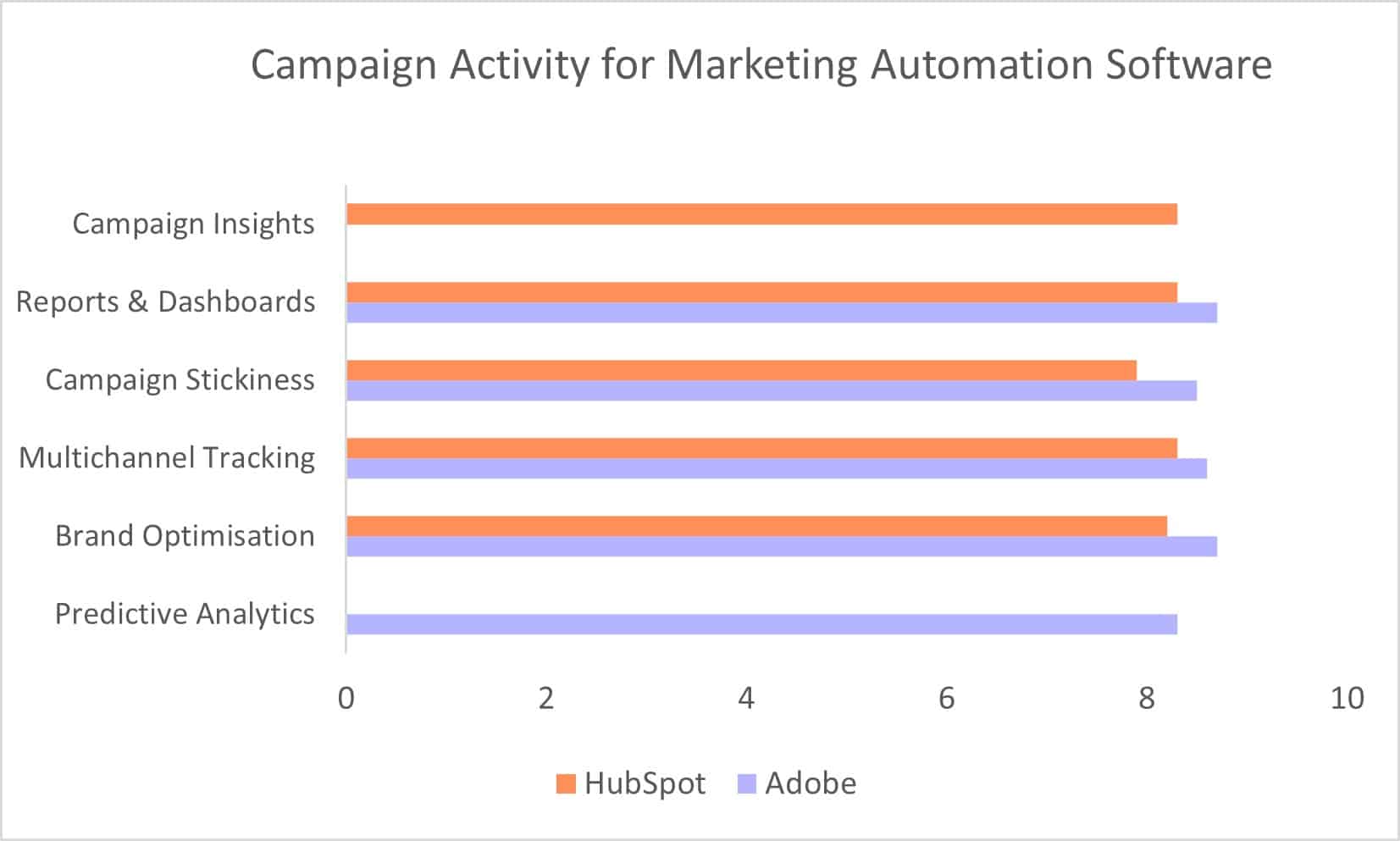
Then when it came to comparing the two as marketing automation platforms and the ability to integrate with other marketing automation software, then HubSpot once again scored better.
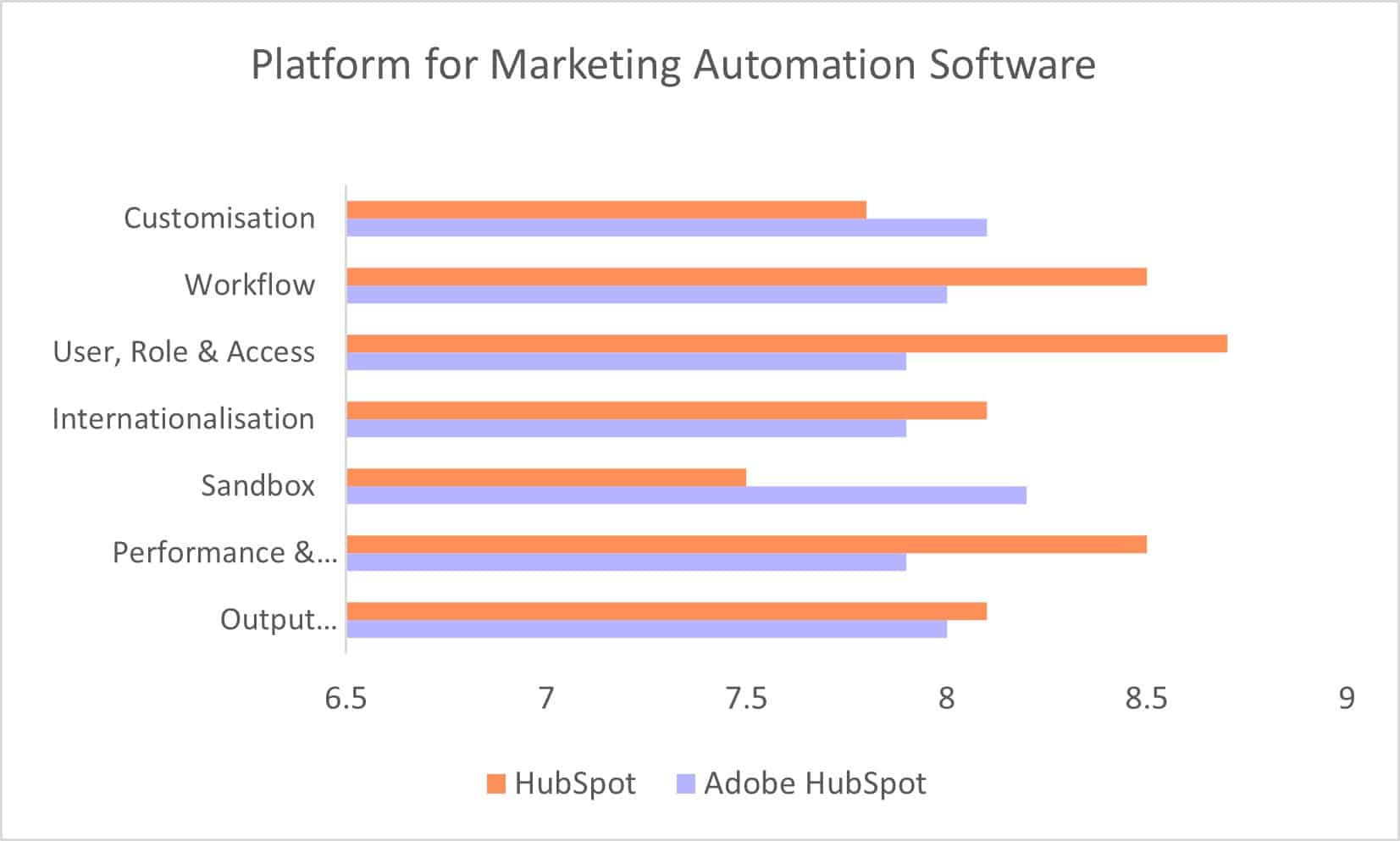
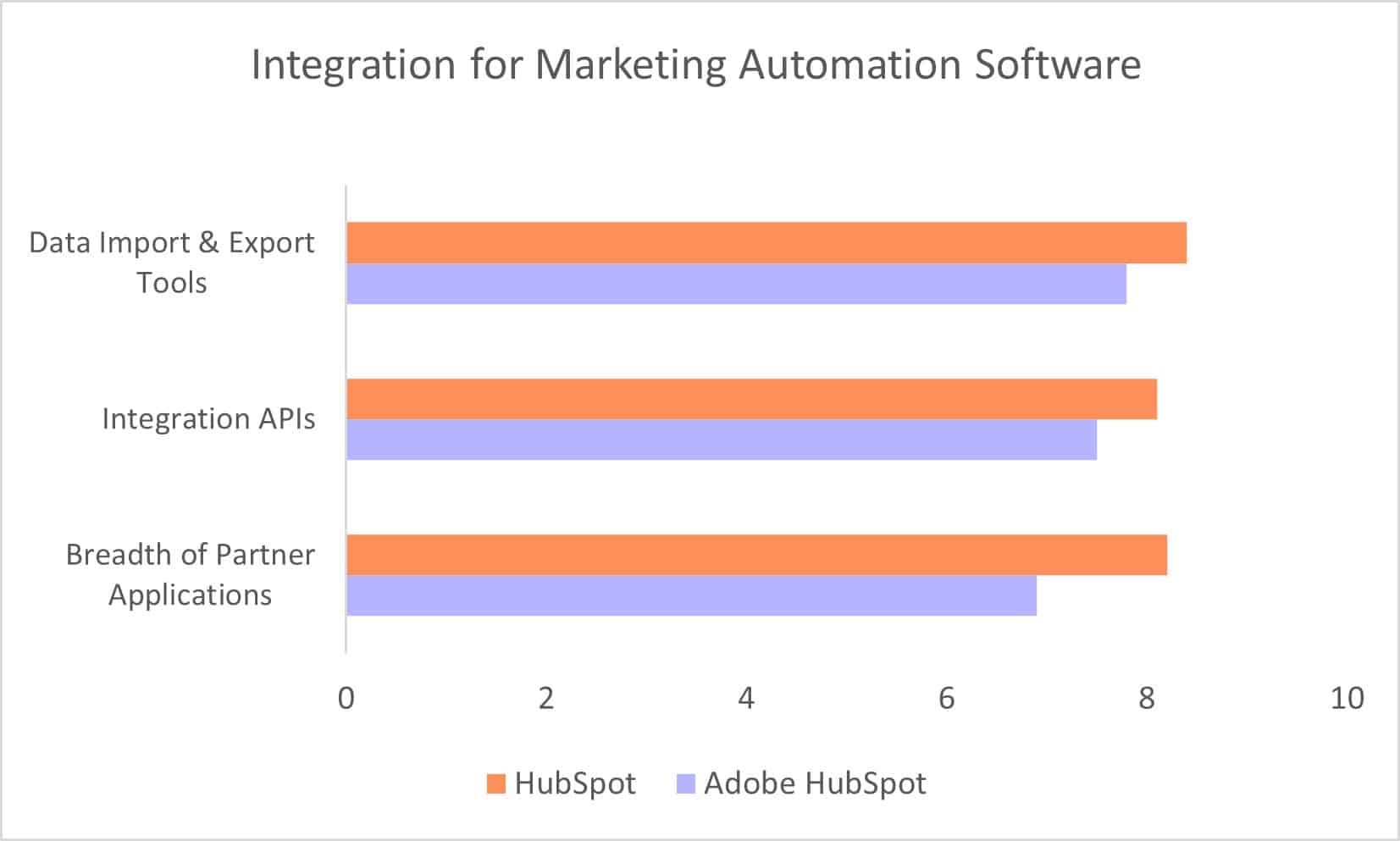
The final area of comparison considered all the above and asked which was rated the best across a number of criteria.
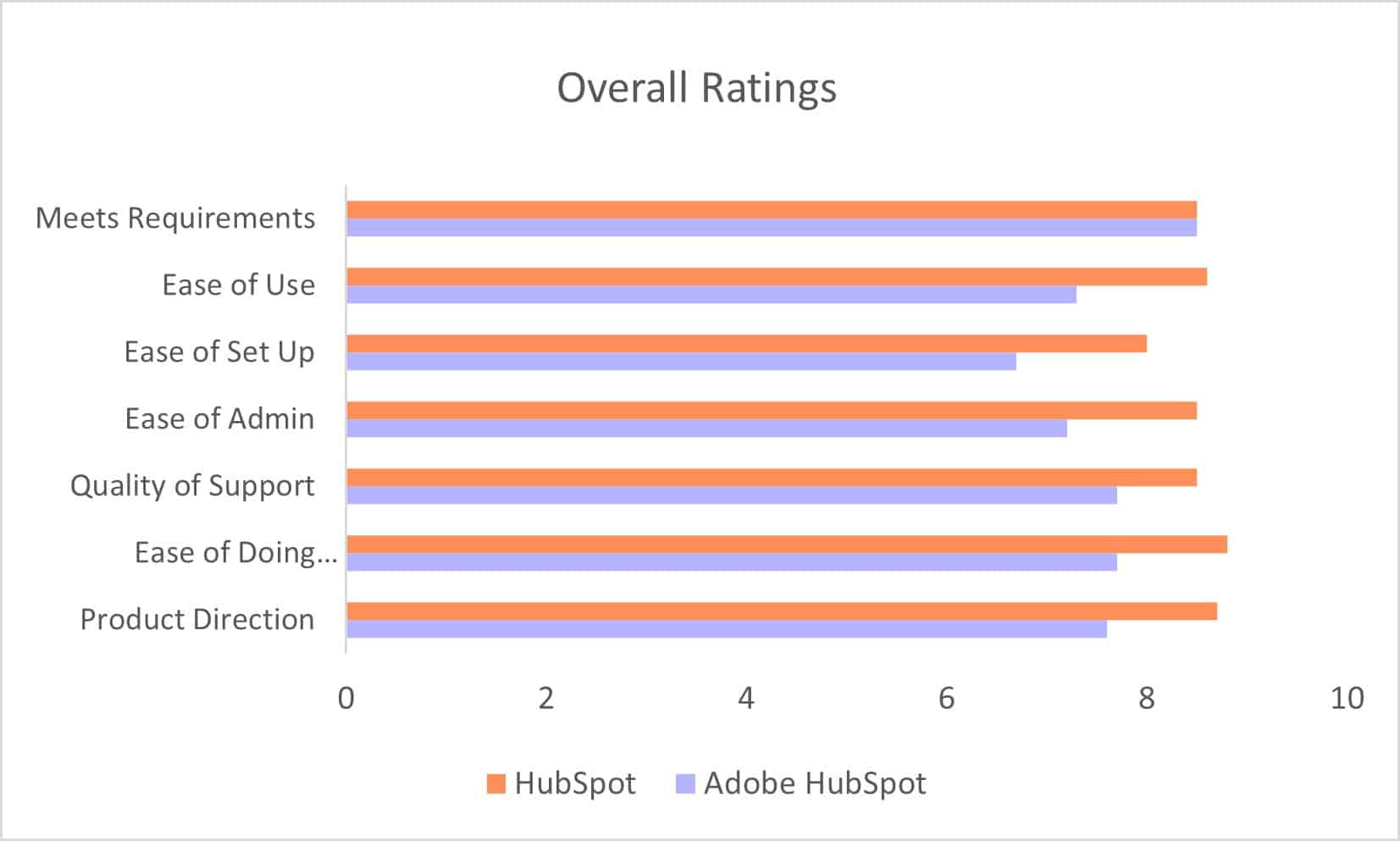
The above will come as no surprise to HubSpot users, as the business was started as a pure play marketing platform based around a CRM that targeted SMEs. It was therefore: always easy to set up, always easy to use, and always had exceptional support. On that basis it has grown into a hugely successful company in a relatively short space of time.
At Attacat, we are a HubSpot Platinum partner and would endorse the above. We’ve worked with many businesses from SMEs to large corporations, and yet to find a company that HubSpot can’t help to deliver better results across marketing, sales and service.
And because it started life as a dedicated marketing platform it has always been possible to integrate existing software with HubSpot. This has been a big help to companies who already have invested in other platforms and don’t want to take a risk of ditching that for something completely new. In our experience, what tends to happen is that businesses do eventually migrate over to HubSpot because of its ease of use and therefore make a saving by only having to work with a single platform.
If you would like to discuss using HubSpot further as part of your marketing strategy, then please make an appointment and we’ll give you and your team a demonstration of the product in action.
* G2 is the world’s largest tech marketplace where businesses can discover, review, and manage the technology they need to reach their potential.
Still Growing…
Over the last few months we are delighted to welcome the following new clients into the fold:
The Royal Mint
Origin Fitness
We’ll tell you more about them in the new year.
View from the other side of the fence
Hannah Porter was working on the client side for many years before switching over to joining us. See what she thinks the main differences are.
Chat with Hannah November 21 from Attacat Internet Marketing on Vimeo.
Tech Thoughts: Make getting to grips with “consent” your New Year’s resolution
If January is a time to tackle what you keep putting off such as losing weight or getting fit, then what better time to get your digital marketing approach to privacy sorted out. The good news is that it isn’t as hard as you think.
Here we set out a handful of simple(ish!) steps to ensure you have a consent process in place for the three digital marketing cornerstones that most businesses rely on, namely:
Analytics
Digital advertising
Email marketing (which is readily adaptable to other direct digital marketing such as chat, push notifications and SMS)
Here are five steps that we think everyone should
now be taking:
- Get a “Do not pass go” cookie banner that actually works
- Put clear privacy information wherever you collect email addresses and get a linked “preference centre”
- Make risk-based decisions on your approach to targeted advertising and analytics
- Draw up a privacy policy that is known and understood by management and customer facing teams
- Implement automated deletion of out of date contact information
Doing the above certainly does not guarantee full compliance. Hopefully though they are achievable steps that businesses can make a firm part of their early 2022 plans. We urge you to make this a key New Year’s resolution and of course would be happy to help you on that journey.
Another new face at Attacat
Lee McDonald
Lee has recently joined as a Data Specialist and is working on Google Analytics and HubSpot integrations. He decided to switch careers from the hospitality industry when COVID hit and went on CodeClan’s Data Analysis intensive 3 month course and has now joined us with his newly updated technical skills.
Away from work still enjoys beer (he brews his own) and travelling.

…And Still Recruiting
We’re not done yet. We are still looking for people to fill the following roles:
- HubSpot Solutions Architect to help solve complex challenges and as a key role as part of the digital transformation team
- Technical Implementation Specialist to bolster the transformation team
- Inbound Marketing Manager to join Hannah, Jenny and Carina
And generally we are on the lookout for anyone with experience of (and a passion for) HubSpot.
For more information on any of the above please visit https://www.attacat.co.uk/jobs
Sign up for our demos of HubSpot features
While some of you will already be aware of HubSpot’s features, they do update and launch new ones on a frequent basis. And while HubSpot’s own descriptions are excellent, we wanted to showcase them based on our own experience and highlight the tools across CRM, Marketing, Sales & Service Hub in action. These are the tools we use to increase productivity & efficiencies whilst also enhancing your customers & prospects experience.
Each of the features will be demonstrated in a short video and presented by the Attacat subject expert. Examples include:
- Snippets & templates
- Conversation inbox and live chat
- Landing page personalisation
- Creating an ad
There will be a total of 8 short 2 minute videos, describing each feature and the benefits that it brings. If you are interested in signing up for these videos that will be released throughout January and February.
The last two years have seen a huge growth in retail ecommerce across the world – global online sales have grown by 11% year-on-year in Q3 2021 (Source: Salesforce’s Q3 2021 Shopping Index) – and while growth had been forecast, the pandemic has undoubtedly accelerated and significantly increased the scale of that growth.
While this has been good news in principle for ecommerce businesses, it has highlighted many challenges for the sector. In fact some of those challenges are causing businesses to falter rather than being able to exploit the opportunity. Here are some of those challenges that you may be all too familiar with.
Ecommerce Challenges
One of the outcomes of the pandemic and resultant growth of ecommerce is the increase in levels of customer expectation. The demands of the customer are now greater than ever. The customer desires low prices, next day delivery, instant comms with the business and 24/7 support.
If a business fails to meet these expectations, then there is very little loyalty shown by the customer and even less chance of them recommending the product or service to others.
At the same time ecommerce companies are facing their own challenges in addition to meeting customer expectations. The marketing team is being asked to grow market share by the business owners because the ecommerce sector is growing so quickly. They are being asked to do so without any increase in resources and at the same time having to cope with new privacy legislation as well as the increasing cost of customer acquisition.
The service team are being particularly challenged by customer demands and are struggling to meet them. In many cases this is due to the inability to track issues until they have been escalated. The likely cause is the use of different platforms which have been added as the company has grown. So they might have separate email, order tracking, livechat, social media channels all operating without the means to see the data collectively. The people responsible for each of the platforms may well be operating in their own silos too – and in some cases working from home will have extended this communication gap..
Add to this the problems caused by Brexit, global supply chain issues and driver shortages then it’s not difficult to see why some businesses are failing to take advantage of the growth in the ecommerce sector. Even giants such as online retailer ASOS are forecasting a significant downturn in their business.
Yet some businesses are clearly enjoying increased growth and market share. So what are they doing right?
There are a number of key factors to being successful in ecommerce in today’s climate.
Customer satisfaction is becoming a key differentiator in a very competitive marketplace
Firstly, making customer satisfaction the key metric of success is necessary as opposed to the volume of customers or new orders. This is a significant mindset shift for many businesses but ultimately is the main driver to growing the business. A satisfied customer is much more likely to repeat purchase and recommend the brand, product or service to others which in turn will help grow the customer base and sales.
If you want to measure customer satisfaction as a KPI, having a single customer view is a prerequisite. A single customer view (SCV) is a centralised platform where there is a holistic view of customers across the entire buyer’s journey. With an SCV, it’s possible to identify and track every interaction with current and prospective customers, which allows for the development of relevant and targeted strategies.
A single customer view combines information from every interaction your customer has with you whether that’s on your site, in email, on social media, with your customer services team or in store. That information can be combined with data about their purchase history as well as information around demographics and other behaviours so you can get a full view of the entire customer journey from initial awareness all the way through to advocacy.
Once in place the SCV is also available to everyone in your company whether in a marketing, sales or service capacity which allows for far greater insights for the whole business.
In order to create the single customer view, a business needs a CRM-based platform that either provides all the functionality or one that can successfully integrate all existing platforms. Platforms such as Salesforce Pardot, Adobe Marketo, Salesforce Eloqua or HubSpot all do the above and depending on the scale of the business will determine the best fit.
Hubspot in particular targets the SME marketplace and is priced accordingly. It’s also designed to scale with the business so there is a low cost of entry with basic functionality that can go all the way to an enterprise level. This helps to de-risk a business that wants to move to a customer satisfaction model in a controlled and affordable way.
Hubspot can also integrate with other existing platforms so the move can be gradual rather than trying to do everything at once. A HubSpot license is usually less expensive than the collective cost of several alternative platforms so there can be a saving as well as digital transformation.
But no matter what your platform is, the same principles apply of being able to collate the data that is needed to give a single customer view and as a result being able to measure customer satisfaction.
Increased Touchpoints
Increasing the number of touchpoints for customers is another important factor in conversion success. It’s sometimes referred to as conversation marketing which essentially means allowing a prospective customer to talk with the seller at the point at which they are about to purchase. If there is any doubt in the prospect’s mind or they need clarification about the product or service, then they want to speak to the business. According to Forrester, 50% of adults will abandon a purchase if you can’t give them a quick answer to their question.
It would seem that most companies appear to make it increasingly difficult for anyone to get in touch with them but this is a mistake and only generates frustration for the prospect or customers.
Frequently Asked Questions can partially help in dealing with issues of concern to the prospect but often they don’t have the patience. So apart from being able to man the switchboard 24/7, which is realistic only for the largest companies, what other options are available?
Chat is increasingly being used by businesses as a solution as it is a flexible option for most businesses. Although chat as a technology has been around for many years, its accelerated growth is doubtless due to the restrictions of people not being able to get to shops as a result of the pandemic.
But it has grown, and is now becoming the preferred means of getting in touch with companies ahead of social media, email and even by phone. Prospects like it because of the convenience, reduced wait times and the anonymity of it.
More than that however, research shows that companies with chat have higher conversion rates of around 12% (Source: LTV Plus) and that 63% of customers are more likely to return to a website that has chat. (Source: Emarketer). We can only see the use of chat continuing to increase.
We believe that the companies that are undoubtedly exploiting the e-commerce boom are those that have adopted customer satisfaction as a key metric and are focusing on the needs of their customers as a priority by using tools like chat. We also believe that by adopting this approach they will continue being successful even after the pandemic has gone and life returns to normal.
If you would like to learn more about any of the above, then please get in touch with us and we can organise a demonstration of some of the key features mentioned.
On October 12th, HubSpot’s leaders took to the stage for INBOUND 21 – well, the virtual stage, since things still aren’t quite back to normal in these post-Covid times. But they didn’t let that stop them – the INBOUND event is one of the world’s biggest and best marketing events, with influential speakers from across all areas of digital and culture. It’s also the forum used to announce innovative exciting new HubSpot updates, and this year was no different. Let’s take a look at the latest HubSpot product updates, as premiered at INBOUND 21.
What did HubSpot announce?
HubSpot is on a mission to become the number one CRM in the world and they believe that means focusing on the three Cs: customisable, well-connected and customer-centric.
All of the key updates announced at at this year’s INBOUND 21 can be bucketed into these three categories – and all of HubSpot’s new features can be summed up in this simple statement from Libby Maurer, VP User Experience: “You shouldn’t have to work for your CRM. Your CRM should just work for you.”
Customisable
When it comes to customising a CRM, HubSpot reckon it’s important not just to customise the database part, but also ensure that it can be customised to make it easy to use for customers. It can be daunting to roll out new features without testing them, so one of the key new features HubSpot has launched is sandboxes, available for Enterprise users.
What are sandboxes?
HubSpot describes these as “production-like portals where you can try new things without impacting your current setup”. Essentially, sandboxes are a safe space that emulates your actual CRM so you can test out new features to see what the impact is before you actually push anything live.
Whether it’s rolling out a new sales pipeline, introducing integrations or developing a new theme, sandboxes enable you to run experiments so you can see what works and what doesn’t without impacting your current setup.
Attacat’s View: This feature is perfect for HubSpot developers & solution architects who need to ensure that custom integrations & additional automations are put through UAT before being released to production. It is an enterprise feature, suited to HubSpot customers whose business processes are heavily reliant on HubSpot.
Are there any other new customisable features?
The introduction of sandboxes could be a game-changer, but it’s not the only new feature that allows you to make your CRM your own.
At INBOUND 21, HubSpot also announced new business units, allowing you to easily manage multiple brands across a single HubSpot portal. If you have multiple brands under one roof, this will be big news for your business, making it much easier to keep on top of your different assets.
There’s also a new set of admin features to make it easier to add users to your CRM and ensure everyone has the right level of access.
Well-connected
HubSpot is striving to improve access to data and reporting, and that’s what they mean by being “connected” – connected to the information you need to take your business to the next level. The big news here is the introduction of the Operations Hub Enterprise.
What’s the Operations Hub?
HubSpot knows that for businesses to grow, they need to run more efficiently. That’s why they launched Operations Hub back in April 2021, giving businesses a unified toolset that allowed teams to connect and clean data. It was originally available in Free, Starter and Professional versions – but at INBOUND 21, it was announced that Operations Hub Enterprise would soon be released.
What does Operations Hub Enterprise offer?
The key feature in the enterprise-level version of the Operations Hub is datasets, a new business intelligence feature that allows ops leaders to curate data collection. They can set up reusable tables for their business, including pre-selected fields and calculated values. This saves ops teams time and gives them more control over their data – and what’s more, it gives downstream business users easier access to data. Datasets ensure that the most meaningful data is collected, it’s consistent across the board, and it’s easy for everyone in the business to use and interpret.
Operations Hub Enterprise also offers fast and easy integration of HubSpot data into Snowflake, an industry-leading data warehouse, with Snowflake Data Share. It’s a turnkey solution, giving companies a fast and easy solution for integrating and analysing data from two different sources.
Attacat’s View: Ideal for Operations & Marketing teams that need to ensure a high level of data quality within HubSpot, saving time & money by automating the data cleanse process. Allowing them to get on with sparking growth rather than spending time tidying up their data.
Customer-centric
There were some big updates to make HubSpot even more customer-focused than ever before, including customer portals, custom surveys and, most exciting of all, native payment processing.
Customer portals
This update is designed to put the power back in the hands of customers, freeing up more time and resources for your customer support teams. Companies can create a branded customer portal where customers can log in to easily view and manage their support tickets, find answers to their questions in the knowledge base and, generally, have a more empowered service experience. Your support agents can stop answering repetitive questions from customers, and customers will be happy with the speed and ease their queries are resolved – it’s a win-win situation!
Attacat’s view: This benefits Service teams with SLA’s in place, where customer service issues are often handled offline and across departments, where your customers are required to be updated on their issue throughout the process.
Custom surveys
Who doesn’t want to increase customer satisfaction? Well, HubSpot has just made it easier for you to ensure your customers feel valued with the introduction of custom feedback surveys. These can be easily customised to your company’s needs so you can gather insights on what matters most to your business – but for ease, HubSpot also offers pre-built net promoter score (NPS), customer satisfaction (CSAT) and customer effort score (CES) surveys. Either way, the easy-to-use built-in dashboards ensure you can see at a glance how your customers feel about your business, instantly picking up on any pain points.
Native payment processing
One of the biggest announcements at INBOUND 21 was the introduction of CRM-powered payment processing, called Payments. Currently only available in the USA, we hope that it’ll expand to the rest of the world soon, as Payments is built natively within the CRM, making the purchase journey much easier for both businesses and customers. You can accept payments within your CRM, meaning there’s no need for multiple tools – you’ll have your website, CRM, reporting, automation and now, payments, all in one place.
Excited by these updates? Want to find out how HubSpot’s new features can help to streamline your business processes? We can help with HubSpot onboarding and management – just get in touch with us today for a free demo or HubSpot audit with one of our experts.
Another New Face at Attacat
Say hi to Carina, our new Inbound Marketing Manager. And if you want to know a bit more about her and what she did before joining the team, watch the video below.
Carina Interview October 2021 from Attacat Internet Marketing on Vimeo.
…And Still Recruiting
We’re not done yet. We are still looking for people to fill the following roles:
- HubSpot Solutions Architect to help solve complex challenges and as a key role as part of the digital transformation team
- Technical Implementation Specialist to bolster the transformation team
- Inbound Marketing Manager to join Hannah, Jenny and Carina
And generally we are on the lookout for anyone with experience of (and a passion for) HubSpot.
For more information on any of the above please visit https://www.attacat.co.uk/jobs
Growing Together – Client News
It’s been a busy month for our clients with some of them exploiting the latest features launched by HubSpot in October at Inbound 21. More about that later. As a Platinum Partner, Attacat has had access to some of the new functionality ahead of the launch and have already worked with our clients where there has been a benefit to their business.
London Grid for Learning Trust (LGFL) is a charitable trust whose mission is the advancement of education. Digital transformation is very much part of that mission. Working with LGFL, we’ve recently introduced both the new Operations Hub and CMS Hub into their HubSpot suite.
Operations Hub allows for greater flexibility to automate business processes and easier integration with other industry standard platforms. Using CMS Hub LGFL now has a savings calculator available in the customer portal and on their main website that uses HubSpot CRM data to present real time savings for existing customers and acts as a lead generation tool for new customers identifying their prospective savings.
Our New Home!
Attacat has moved. We’re now just off McDonald Road in The Stack. You can’t miss it. Just look for the old brick chimney stack. The current COVID restrictions has meant that we can’t fully utilise it with everyone just yet, but we hope to be able to welcome you to our new offices soon.
In the meantime, here’s a quick tour.
The Stack from Attacat Internet Marketing on Vimeo.



